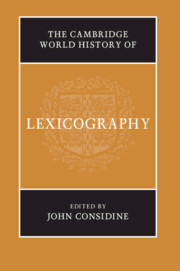Book contents
- The Cambridge World History of Lexicography
- The Cambridge World History of Lexicography
- Copyright page
- Contents
- Contributors
- Editor’s Acknowledgements
- Introduction
- Part I The Ancient World
- 1 Ancient Mesopotamia
- 2 Ancient and Coptic Egypt
- 3 Ancient China
- 4 Ancient India
- 5 The Greco-Roman World
- Part II The Pre-Modern World
- Part III The Modern World: Continuing Traditions
- Part IV The Modern World: Missionary and Subsequent Traditions
- Appendix 1 The Language Varieties
- Appendix 2 The Lexicographers
- Primary Sources
- Secondary Sources
- Index
1 - Ancient Mesopotamia
from Part I - The Ancient World
Published online by Cambridge University Press: 01 September 2019
- The Cambridge World History of Lexicography
- The Cambridge World History of Lexicography
- Copyright page
- Contents
- Contributors
- Editor’s Acknowledgements
- Introduction
- Part I The Ancient World
- 1 Ancient Mesopotamia
- 2 Ancient and Coptic Egypt
- 3 Ancient China
- 4 Ancient India
- 5 The Greco-Roman World
- Part II The Pre-Modern World
- Part III The Modern World: Continuing Traditions
- Part IV The Modern World: Missionary and Subsequent Traditions
- Appendix 1 The Language Varieties
- Appendix 2 The Lexicographers
- Primary Sources
- Secondary Sources
- Index
Summary
The history of Mesopotamian lexicography in cuneiform extends from the very beginning of writing (around 3200 BC) to the demise of cuneiform in the first centuries of our own era. Lexical texts accompany cuneiform writing in all periods and all areas where this writing system was used. They have been found not only in Babylonia (southern Iraq) and Assyria (northern Iraq), but also in present-day Iran, Syria, Turkey, Israel, and Egypt.
One may think of lexical lists as something between a dictionary and an encyclopedia – they organize, transmit, and preserve knowledge. Lexical lists have drawn the attention of cuneiform scholars from the earliest days of Assyriology, because they explain how to read and understand the ancient writing system. As such, they were invaluable in the early days of decipherment, and they still fulfil that essential function in modern philological research. Lexical lists are the earliest scholarly genre in ancient Mesopotamia, and thus they may claim to be the earliest scholarly genre in the history of humanity. Lexicography, therefore, also plays an important role in discussions of the history of Mesopotamian scholarship and education.
- Type
- Chapter
- Information
- The Cambridge World History of Lexicography , pp. 11 - 35Publisher: Cambridge University PressPrint publication year: 2019

